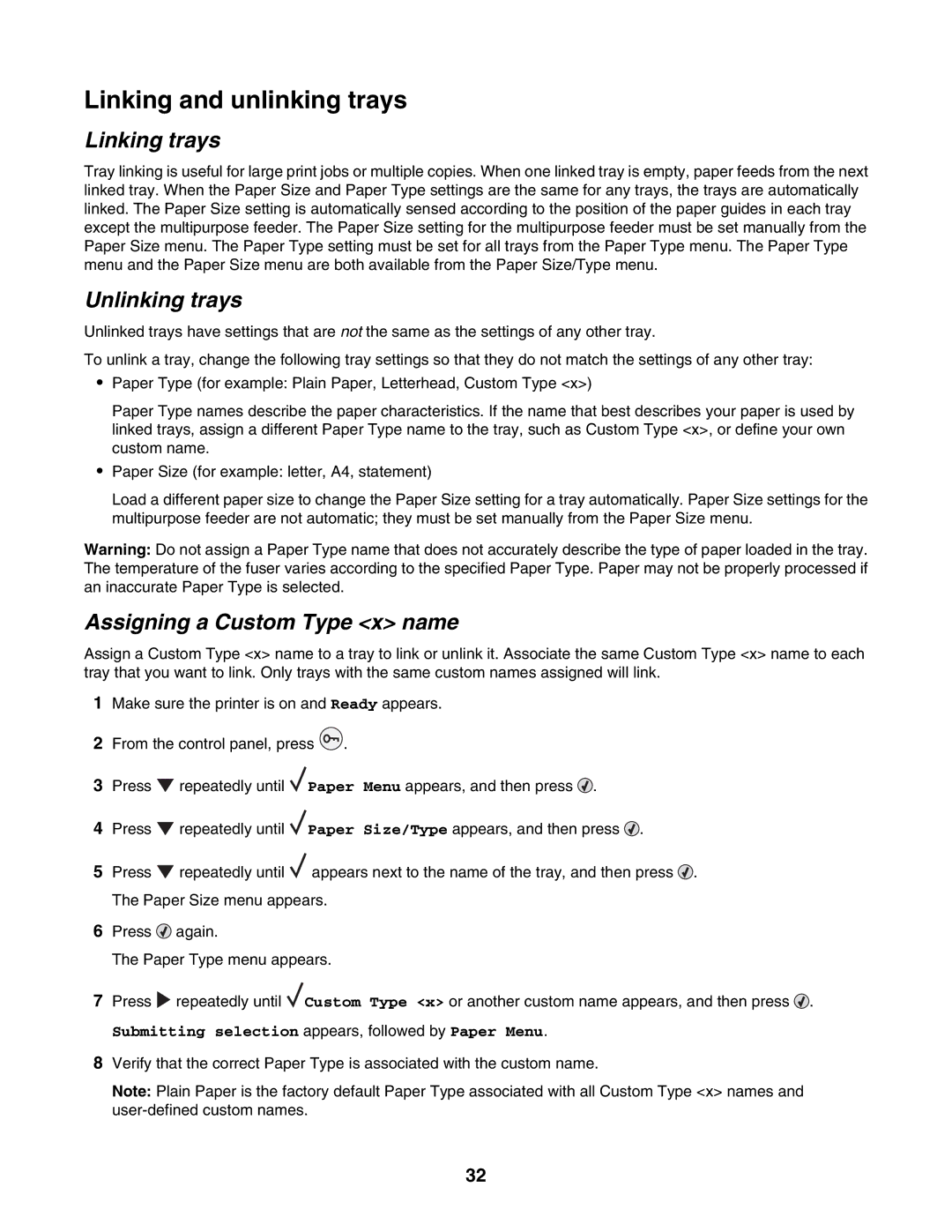Linking and unlinking trays
Linking trays
Tray linking is useful for large print jobs or multiple copies. When one linked tray is empty, paper feeds from the next linked tray. When the Paper Size and Paper Type settings are the same for any trays, the trays are automatically linked. The Paper Size setting is automatically sensed according to the position of the paper guides in each tray except the multipurpose feeder. The Paper Size setting for the multipurpose feeder must be set manually from the Paper Size menu. The Paper Type setting must be set for all trays from the Paper Type menu. The Paper Type menu and the Paper Size menu are both available from the Paper Size/Type menu.
Unlinking trays
Unlinked trays have settings that are not the same as the settings of any other tray.
To unlink a tray, change the following tray settings so that they do not match the settings of any other tray:
•Paper Type (for example: Plain Paper, Letterhead, Custom Type <x>)
Paper Type names describe the paper characteristics. If the name that best describes your paper is used by linked trays, assign a different Paper Type name to the tray, such as Custom Type <x>, or define your own custom name.
•Paper Size (for example: letter, A4, statement)
Load a different paper size to change the Paper Size setting for a tray automatically. Paper Size settings for the multipurpose feeder are not automatic; they must be set manually from the Paper Size menu.
Warning: Do not assign a Paper Type name that does not accurately describe the type of paper loaded in the tray. The temperature of the fuser varies according to the specified Paper Type. Paper may not be properly processed if an inaccurate Paper Type is selected.
Assigning a Custom Type <x> name
Assign a Custom Type <x> name to a tray to link or unlink it. Associate the same Custom Type <x> name to each tray that you want to link. Only trays with the same custom names assigned will link.
1Make sure the printer is on and Ready appears.
2From the control panel, press ![]() .
.
3Press ![]() repeatedly until
repeatedly until ![]() Paper Menu appears, and then press
Paper Menu appears, and then press ![]() .
.
4Press ![]() repeatedly until
repeatedly until ![]() Paper Size/Type appears, and then press
Paper Size/Type appears, and then press ![]() .
.
5Press ![]() repeatedly until
repeatedly until ![]() appears next to the name of the tray, and then press
appears next to the name of the tray, and then press ![]() . The Paper Size menu appears.
. The Paper Size menu appears.
6Press ![]() again.
again.
The Paper Type menu appears.
7Press ![]() repeatedly until
repeatedly until ![]() Custom Type <x> or another custom name appears, and then press
Custom Type <x> or another custom name appears, and then press ![]() .
.
Submitting selection appears, followed by Paper Menu.
8Verify that the correct Paper Type is associated with the custom name.
Note: Plain Paper is the factory default Paper Type associated with all Custom Type <x> names and
32
